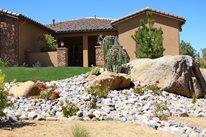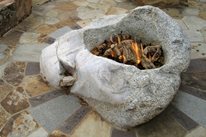Tips for Using Boulders in Your Landscape Design
A Portland landscaper shares his boulder placement expertise
-
Locally sourced boulders lend regional authenticity to this Pacific Northwest landscape.
-
In this Japanese-inspired garden, the boulders are meant to represent mountains. The one standing upright is supported by a bed of gravel and concrete.
-
This boulder was set in place and a wooden privacy screen was built right over it, creating the impression that the stone had always been there.
-
Here boulders were integrated along the edges of a path. Boulders can be used to elevate man-made materials such as pavers or concrete.
- 1
- 2
- 3
- 4
Including boulders in your front yard or backyard landscape will lend authenticity to your property. For this reason, Ben Bowen of Ross NW Watergardens in Portland, OR integrates boulders into many of his projects. Bowen cautions that boulders can be used improperly; he often sees homes with boulders that are too small or just randomly dropped atop the ground. Check out his tips to ensure that your boulders are achieving their maximum potential.
- Don’t be afraid to go big
“When you are at the rock yard, it is easy to think that a boulder is large enough. However, when you get it to your property it can look dwarfed by your landscape,” says Bowen. He recommends selecting a boulder that may at first appear too big, it will likely be just right once it is placed. - Set each boulder down into the dirt
In a natural setting, boulders don’t hover atop the earth, instead just a portion of the rock is revealed. This same effect is easy to recreate at home. “Boulders should always be set a few inches below grade,” says Bowen, “the size and shape of the particular boulder will dictate just how deep it should be buried.” - Arrange your boulders in a variety of ways
Setting all the boulders in a landscape with the flat side up will create a mundane and methodical look that does not mimic nature. “We set our boulders in a variety of ways, some lay flat while others reach for the sky,” explains Bowen. Having the right equipment is essential for being able to maneuver boulders into the exact position desired. Ross NW Watergardens uses custom-made braided metal cables attached to a tractor, forklift or crane depending on the site. - Group boulders
A lone boulder will look quite out of place, which is why Bowen usually groups them in threes. His strategy for creating a boulder grouping is to place two boulders very near each other, or even touching, and then add a third nearby. - Use local rock
Occasionally, Ross NW Watergardens is able to use boulders found on their project sites, but typically they are selected from the inventory of local suppliers. “Most of our boulders come from the Columbia River Gorge,” Bowen states. These boulders are gray with accents of blue, tan and bronze. It is best to select boulders from a source near you so that the colors and nature of the stone authentically represent your region. - Elevate man-made materials with boulders
Bowen likes to use boulders in conjunction with man-made paving materials. “Of course the preference would be to have natural stone paving, but often this is not an option,” Bowen says. When pavers or concrete must be used for walkways, driveways or patios, Ross NW Watergardens integrates boulders along the border. “We set the boulders first and then pave around them, cutting the pavers to fit or making other necessary adaptations,” explains Bowen. - Use a base of gravel and concrete to keep boulders from settling
In certain situations, it is important to make sure a boulder stays exactly where you put it. Bowen explains that this is the case when they are integrated with paving or a main focal point in your landscape. “A bed of gravel and concrete below the boulder will hold it in position and prevent any settling or shifting,” he says. This can be especially useful when trying to arrange a boulder in a dramatic fashion. - Respect the age of boulders
The overall goal of boulder placement is to make them look as if they have always been there. “There are a variety of ways to go about creating the impression that a rock has been around for a very long time,” says Bowen. On one project, Ross NW Watergardens set a boulder and then built a privacy screen right over the top of the rock. This unique approach makes people assume the rock was there years before the screen. In other cases they have encouraged moss to grow on the face of boulders to accomplish a similar aged appearance. - Let the shape of the boulders and your landscape’s style dictate arrangement
According to Bowen, his years of experience have given him the ability to instinctively feel what side is up on a boulder. The shape dictates whether the boulder should lie flat or stand upright. Another way to determine how boulders should be arranged is to take cues from the style of your landscape. “In a laid back landscape you don’t want the boulders to be overly dramatic, while in a Japanese garden they are used to emulate mountains and should jut upwards accordingly,” notes Bowen. - Light boulders for a nighttime focal point
Ross NW Watergardens often lights the boulders they use in their landscaping projects. Bowen’s first rule for lighting boulders is that if they are not a focal point during the day, don’t bother lighting them at night. His second rule is to use a spotlight that provides a warm glow. “Backlighting is also a great way to light boulders. Try uplighting a tree behind your boulder grouping to produce a silhouette-like effect,” he suggests.
Ross NW Watergardens
P: (503)761-3683
7607 SE 104th Ave
Portland, OR 97266
|
Contributing Author: Sarah Hutchinson, contributing writer for Landscaping Network |



 Landscape Boulders
Landscape Boulders Boulder Ideas
Boulder Ideas Boulder Pictures
Boulder Pictures

